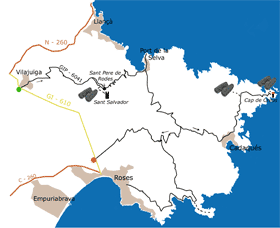Cap de Creus Natural Park Itinerary 1/2
Starting point: The village of Vilajuïga
Time: a whole day
After checking the area between Garriguella and Vilajuïga for Red-rumped Swallow, follow the signs from Vilajuïga to “Sant Pere de Rodes”. The first stretch of the road ascends through olive groves where it is worth stopping to look for Orphean Warbler and Sardinian Warbler in the bushy areas. Further on up the valley the landscape becomes more open where you should search for Black-eared Wheatear, Rock Bunting and Thekla Lark in the more broken, rockier terrain and Dartford Warbler and Subalpine Warbler in areas with low bushes. Check any areas with brambles for Melodious Warbler, and the obviously more recently burnt areas for interesting species such as Ortolan Bunting and Tawny Pipit.
Follow on to the car park for the Benedictine monastery of Sant Pere de Rodes, worth a visit for the 12th Century Romanesque building in itself, but also for the views and for Black Redstart and Blue Rock Thrush that inhabit its walls. From here it is highly recommended to follow the path that leads up to Sant Salvador, quite a steep ascent that will take about an hour. In the summer Blue Rock Thrush is joined by Rock Thrush, and there is also Crag Martin, Alpine and Pallid Swift (as well as Common Swift) and a good assortment of warblers. Sant Salvador itself is the highest peak on the peninsula of Cap de Creus and as such offers excellent views of the surrounding terrain, as well as the chance of spotting Bonelli's Eagle and Peregrine Falcon in flight over the sierras. In the winter months this is also a reliable spot for small groups of Alpine Accentor.
Return to the vehicle and follow the road that winds its way down to Port de la Selva. Take a break and stroll around this attractive town if desired, or keep on birding by turning right at the entrance to Port de la Selva and following on the Coll de Perafita.


